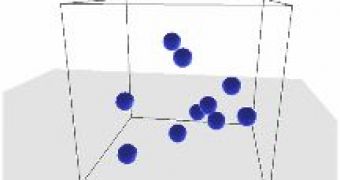Scientists have developed a new model of social networks that makes surprisingly accurate predictions, given its almost obscene simplicity. The model treats humans as being simply a bunch of bouncing balls that collide with each other at random, each collision changing in a certain way the probability of future collisions. The model's predictions about the community structure and the formation of groups as well as about the evolution of general acquaintances and even of sexual contacts fit the empirical data taken from a survey of more than 90,000 U.S. students regarding friendships and from studies of how HIV is spreading in a community.
We tend to consider individuals are very complex creatures, driven by many factors, and the reasons why people get to know each other and sometimes decide to become friends are not exactly easy to pinpoint. However, Marta Gonzalez, Pedro Lind and Hans Herrmann haven't even tried to do such a thing. They simply tried to put forward a birds' eye view of human interactions. They found that the characteristics of social networks emerge "in a very natural way."
According to Gonzalez, statistical physics and human behavioral studies have a long history of inspiring each other, which makes physicists' desire to understand social networks a natural interest.
"The idea behind our model, though simple, is different from the usual paradigmatic approaches," said Gonzalez. "We consider a system of mobile agents (students), which at the beginning have no acquaintances; by moving in a continuous space they collide with each other, forming their friendships."
Each collision changes the "particle"'s direction and speed. Thus, the motion of the "particle" in this abstract space mimics the fact that the chance of meeting someone new depends on the most recent acquaintances.
According to the model, after some time, the system reaches a quasi-stationary state and the scientists were able to compare the structure of this state to the observed structure of a group of many individuals. The system of bouncing balls gets from one quasi-stationary state to another quasi-stationary state - and this allows modeling how friendships evolve in time and how clustering occurs.
"With this new framework, we show that specific velocity and collision rules are able to reproduce the statistical and structural features of empirical social networks," said Gonzalez. "Therefore, this model seems to have the novelty of bringing together all the previous developments for collision theory with the empirical results of socio-dynamics."
Of course, the motion of these abstract particles does not represent the actual motion of individuals in space, how they go from place to place; the motion of the particles symbolizes the evolution of individuals in the virtual space of all possible acquaintances, it symbolizes how connections between people change. What's interesting is that everything depends only on one factor: the collision rate. If the collision rate is higher than some 'critical' value the social structure emerges.
The scientists then managed even to take into consideration specific types of interactions - such as sexual contacts. For doing this they assigned to the sexual contacts an intrinsic property that could then be used to separate sexual contacts from all other types of social contacts. In this case, the model reproduced the real sexual contact network found in a tracing study of HIV tests.
This model could have widespread implications. For example it could be used in marketing studies to model the flow of information among the public.

 14 DAY TRIAL //
14 DAY TRIAL //